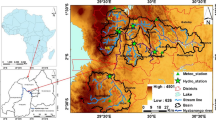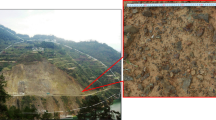Abstract
An old landslide deposit situated in Deqin County, Yunnan Province, China, was used to investigate the effects of local accumulation of crushed stone soil on infiltration of intense rainfall. This study considers the infiltration process and landslide stability using finite-element method (FEM)-based models and a physical experimental model. The results show that reactivation of the old landslide was triggered by intense rainfall that occurred on 7–9 October 2012. The crushed stone soil played a key role in the rapid infiltration of rainfall deep into the landslide deposit. Accumulated rainfall and runoff water caused the formation of high pore water pressure in the crushed stone soil, which induced higher infiltration of the surrounding soil due to the higher gradient. The original slip zone was another key factor, as infiltrated water accumulated at the slip zone and form a high pore water pressure due to the lower permeability of the slip zone. The high pore water pressure that formed at the slip zone was the main factor triggering reactivation of the landslide during the rainfall.



















Similar content being viewed by others
References
Au SWC (1998) Rain-induced slope instability in Hong Kong. Eng Geol 51:1–36
Azzoni A, Chiesa S, Frassoni A, Govi M (1992) The Valpola landslide. Eng Geol 33:59–70
Chen KT, Wu JH (2018) Simulating the failure process of the Xinmo landslide using discontinuous deformation analysis. Eng Geol 239:269–281
Chen W, Mo H, Chen L (2009) Study on rainfall infiltration process and the biggest infiltration depth for unsaturated soil slope. Min Metall Eng 29(6):13–16
Cho SE, Lee SR (2001) Instability of unsaturated soil slopes due to infiltration. Comput Geotech 28:185–208
Ferrari A, Ledesma A, González DA, Corominas J (2011) Effects of the foot evolution on the behaviour of slow-moving landslides. Eng Geol 117(3-4):217–228. https://doi.org/10.1016/j.enggeo.2010.11.001
Fredlund DG, Rahardjo H (1993) Soil mechanics for unsaturated soils. Wiley-Interscience Publication, John Wiley & Sons, Inc., New York
Griffiths DV, Lane PA (1999) Slope stability analysis by finite elements. Géotech 49(3):387–403
Guthrie RH, Evans SG, Catane SG, Zarco MAH, Saturay RM (2009) The 17 February 2006, rock slide-debris avalanche at Guinsaugon Philippines: a synthesis. Bull Eng Geol Environ 68:201–213
Hossain MK (2010) Effect of rainfall on matric suction and stability of a residual granite soil slope. J Dhaka Univ Eng Technol 1:37–41
Li T, He B, Chen Z et al (2016) Effects of gravel on infiltration, runoff, and sediment yield in landslide deposit slope in Wenchuan earthquake area, China. Environ Sci Pollut Res 23:12075–12084
Lin H, Yu Y, Li G (2009) Influence of rainfall characteristics on soil slope failure. Chin J Rock Mech Eng 28:198–204 [in Chinese]
Liu C (2014) Genetic types of landslide and debris flow disasters in China. Geol Rev 60(4):858–868 [in Chinese]
Liu X-X, Xia Y-Y et al (2007) Study on stability of high-filled embankment slope of highly weathered soft rock under rainfall infiltration. Rock Soil Mech 28:1705–1709 [in Chinese]
Lou Y-Q (2007) Finite element analysis of slope seepage and stability due to rainfall infiltration. J Hydraul Eng Suppl:346–351 [in Chinese]
Mao C, Duan X, Li Z (1999) Numerical computation in seepage flow and program applications. Hehai University Press, Nanjing [in Chinese]
Matsui T, San K-C (1992) Finite element slope stability analysis by shear strength reduction technique. Soils Found 32:59–70
Miller S, Brewer T, Harris N (2009) Rainfall thresholding and susceptibility assessment of rainfall-induced landslides: application to landslide management in St Thomas, Jamaica. Bull Eng Geol Environ 68:539–550
Ng CWW, Shi Q (1998a) Influence of rainfall intensity and duration on slope stability in unsaturated soils. Q J Eng Geol 31:105–113. https://doi.org/10.1144/GSL.QJEG.1998.031.P2.04
Ng CWW, Shi Q (1998b) A numerical investigation of the stability of unsaturated soil slopes subjected to transient seepage. Comput Geotech 22:1–28
Ping Y, Liu M, Zheng S (2004) Stability analysis of expansive soil slope with rainfall infiltration. Chin J Rock Mech Eng 23:4478–4484 [in Chinese]
Schnellmann R, Busslinger M, Schneider HR (2010) Effect of rising water table in an unsaturated slope. Eng Geol 114:71–83
Sun G (1988) Typical slopes in China. Science Press, Beijing [in Chinese]
Sun J, Liu Q, Li J et al (2009) Effects of rainfall infiltration on deep slope failure. Sci China Ser G Phys Mech Astron 52(1):108–114
Tang YM, Xue Q, Li ZG et al (2015) Three modes of rainfall infiltration inducing loess landslide. Nat Hazards 79:137–150
Van Genuchten MT (1980) A close form equation predicting the hydraulic conductivity of unsaturated soil. Soil Sci Soc Am J 44:892–898
Vanapalli SK, Fredlund DG, Pufahl DE, Clifton AW (1996) Model for the prediction of shear strength with respect to soil suction. Can Geotech J 33:379–392
Wei N, Qian P-Y, Fu X-D (2006) Effects of rainfall infiltration and evaporation on soil slope stability. Rock Soil Mech 27:778–786 [in Chinese]
Wu C-F, Zhu X-R et al (2008) Analysis of soil slope’s transient stability under intensive rainfall. Rock Soil Mech 29:386–391 [in Chinese]
Wu JH, Chen JH, Lu CW (2013) Investigation of the Hsien-du-Shan rock avalanche caused by typhoon Morakot in 2009 at Kaohsiung county, Taiwan. Int J Rock Mech Min Sci 60:148–159
Ying K, Wang Y, Tang Z (2002) Mechanism and dynamic simulation of landslide by precipitation. Geol Sci Technol Inf 21:75–78 [in Chinese]
Zhang SY, Wang RG (2004) Identification of rainfall to infiltration depth of high filling embankment and finite element analysis for stability. Subgrade Eng 5:17–20
Zhang LT, Wu HW, Bao CG, Gong BW (2003) Artificial rainfall infiltration tests on a well-instrumented unsaturated expansive soil slope. Rock Soil Mech 24(2):151–158
Zhong L (1999) Case study on significant geo-hazards in China. Chin J Geol Hazard Control 10:l–10 [in Chinese]
Zhu W, Cheng N-J et al (2006) Some fundamental problems of unsaturated seepage. Chin J Geotech Eng 28:235–240 [in Chinese]
Acknowledgements
We are grateful to the academic and technical staff of the State Key Laboratory of Geohazard Prevention and Geo-Environment Protection (SKLGP) at Chengdu University of Technology, China. This research was supported by the National Natural Science Foundation of China (grant no. 41472274) and Independent Subject Foundation of SKLGP (SKLGP2017Z010).
Author information
Authors and Affiliations
Corresponding author
Rights and permissions
About this article
Cite this article
Tu, G., Huang, D., Huang, R. et al. Effect of locally accumulated crushed stone soil on the infiltration of intense rainfall: a case study on the reactivation of an old deep landslide deposit. Bull Eng Geol Environ 78, 4833–4849 (2019). https://doi.org/10.1007/s10064-019-01460-y
Received:
Accepted:
Published:
Issue Date:
DOI: https://doi.org/10.1007/s10064-019-01460-y




